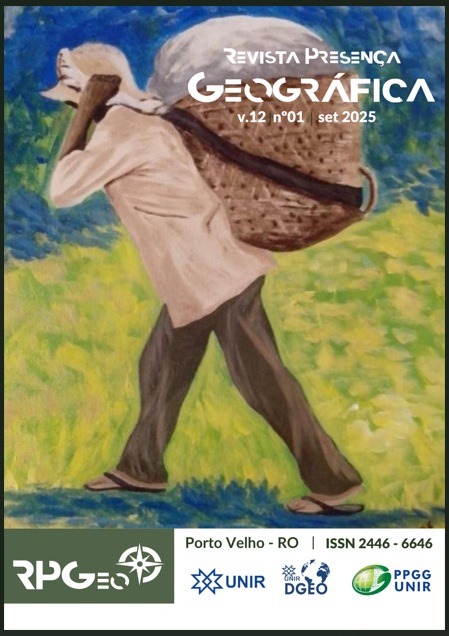BASKETRY AS A CONTRIBUTION TO CULTURAL HERITAGE THAT PRODUCES FAMILY INCOME IN THE VILLAGE OF NHACUNDELA (MOZAMBIQUE)
DOI:
https://doi.org/10.36026/rpgeo.v12i1.8309Keywords:
Patrimônio Cultural, Cestaria, Renda familiarAbstract
This research seeks to analyze the contribution of cultural heritage to the production of family income, focusing on basketry in the village of Nhacundela. The study was based on a qualitative approach, through direct observation assisted by the collection of photographs and interviews with the local community, to obtain relevant data about the research. The results show that in the village, basketry is used for domestic, ritual and commercial purposes. The baskets found in Nhacundela are made from natural materials, extracted from plants such as Hyphaene Coriacea (hanga). The knowledge involved in the practice of basketry in Nhacundela is passed from generation to generation. The activity of basket weaving in the village of Nhacundela has a clear advantage as a source of income generation, although there are few profits for artisans due to the fact that this activity depends on consumer demand for these products. The basket used by the community to preserve food carries a symbolism that cannot be dissociated from memory, from ritual life. The cultural characteristic of basketry can be an element that, in addition to offering differentiated products to tourist demand, in a tangible sense, also allows visitors to have a different experience, in an intangible sense, since contact with the receiving community allows for an exchange of experiences.
References
CONSTITUIÇÃO DA REPÚBLICA DE MOÇAMBIQUE. 22 de Dezembro de 2004. I série no 51.
JOPELA, A. Definição de conceitos-chaves/ Definição do significado cultural do património cultural imóvel, In: Jopela, A. (Coord.) Manual de Conservação do Património Cultural Imóvel em Moçambique: Maputo: Ministério da Cultura-Direcção Nacional do Património Cultural. Maputo, 2014.
LEI 10/88 de 22 de dezembro, protecção legal dos bens materiais e imateriais do património cultural moçambicano.
LEITE, E. Turismo Cultural e Patrimônio Imaterial no Brasil. Coleção Verde Amarela vol. 6 - Ó Pátria amada, 2011.
MAE. Perfil do Distrito de Inharrime, província e Inhambane, 2005.
SANTOS, S. et al. Atitudes, Valores Culturais e Desenvolvimento, Lisboa, SEDES – Associação para o Desenvolvimento Económico e Social, 2010.
COSTA, R. L.; LIMA, T. A. A ARTE E A TÉCNICA DE TRANÇAR NA PRÉ-HISTÓRIA DE PERNAMBUCO: A Cestaria dos Sítios Alcobaça e Furna do Estrago. V31N2, pp. 102-152,. DOI: 10.20891/clio.v31i2p102-152. Clio Arqueológica, 2016.
FEITOSA, A. C.; MENENDEZ, L. ESPACO ELUGAR: Cestaria Canela Ramkokamekrá. Vol. 17. ISSN 1807-6971. DOI: 10.35355/0000048. Revista de história e estudos culturais, 2020.
BATISTA, N. ENTRELAÇAR. Cestaria Portuguesa: Intersecções entre Artesanato e Arquitetura. Dissertação MIARQ. Porto, 2018.
Downloads
Published
Issue
Section
License
Copyright (c) 2025 Inordine Abdul Khadry

This work is licensed under a Creative Commons Attribution-NonCommercial-NoDerivatives 4.0 International License.
This work is licensed under Creative Commons Attribution-NonCommercial-NoDerivatives 4.0 Internacional license.
Authors who publish in this journal agree to the following terms:
- Authors retain the copyright and grant the journal the right to first publication, with the work simultane ously licensed under Creative Commons Attribution-NonCommercial-NoDerivatives 4.0 Internacional License that allows the sharing of the work with acknowledgment of authorship and initial publication in this journal.
- Authors are authorized to assume additional contracts separately, for non-exclusive distribution of the version of the work published in this journal (ex, publishing in institutional repository or as a book chapter), with acknowledgment of authorship and initial publication in this journal.
- Authors are allowed and encouraged to publish and distribute their work online (ex.: in institutional repositories or on their personal page) at any point before or during the editorial process, as this can generate productive changes, as well as increase the impact and the citation of the published work (See The Free Acess Policy).







